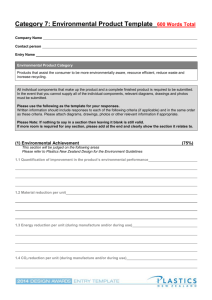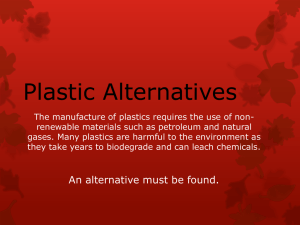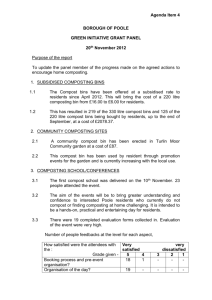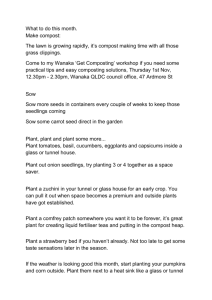Compostable Plastics in New Zealand Executive summary In
advertisement
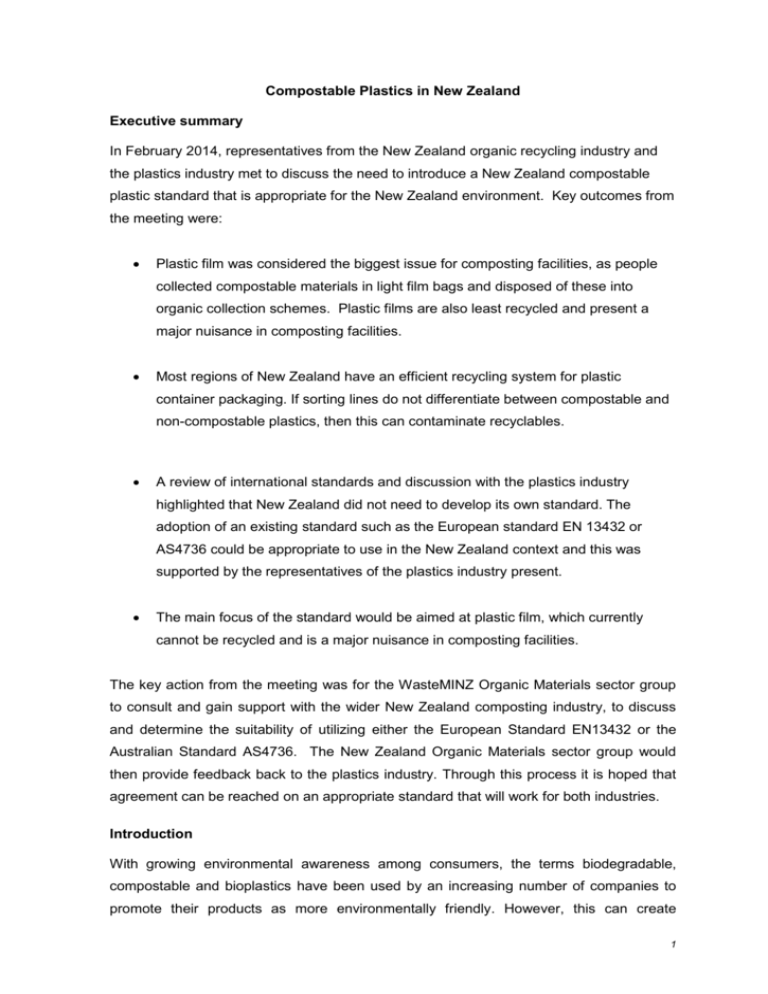
Compostable Plastics in New Zealand Executive summary In February 2014, representatives from the New Zealand organic recycling industry and the plastics industry met to discuss the need to introduce a New Zealand compostable plastic standard that is appropriate for the New Zealand environment. Key outcomes from the meeting were: Plastic film was considered the biggest issue for composting facilities, as people collected compostable materials in light film bags and disposed of these into organic collection schemes. Plastic films are also least recycled and present a major nuisance in composting facilities. Most regions of New Zealand have an efficient recycling system for plastic container packaging. If sorting lines do not differentiate between compostable and non-compostable plastics, then this can contaminate recyclables. A review of international standards and discussion with the plastics industry highlighted that New Zealand did not need to develop its own standard. The adoption of an existing standard such as the European standard EN 13432 or AS4736 could be appropriate to use in the New Zealand context and this was supported by the representatives of the plastics industry present. The main focus of the standard would be aimed at plastic film, which currently cannot be recycled and is a major nuisance in composting facilities. The key action from the meeting was for the WasteMINZ Organic Materials sector group to consult and gain support with the wider New Zealand composting industry, to discuss and determine the suitability of utilizing either the European Standard EN13432 or the Australian Standard AS4736. The New Zealand Organic Materials sector group would then provide feedback back to the plastics industry. Through this process it is hoped that agreement can be reached on an appropriate standard that will work for both industries. Introduction With growing environmental awareness among consumers, the terms biodegradable, compostable and bioplastics have been used by an increasing number of companies to promote their products as more environmentally friendly. However, this can create 1 confusion with both consumers and composting facilities in terms of determining what products can be successfully composted. In February 2014, representatives from the New Zealand Organic Materials sector group meet with representatives from the Australasian plastics industry to discuss compostable plastics, biodegradable plastics and recycling. The objective of the meeting was to find common ground and a pathway forward in regards to determining an appropriate standard for organic waste processors to require for compostable materials being received in their facilities. This paper summarises the discussion, defines the key terms, outlines the international standards used and proposes possible solutions for the New Zealand market. The Plastics New Zealand guide to degradable plastics in New Zealand uses the following definitions: Biodegradable: Any organic substance capable of being broken down by microorganisms in the presence of oxygen (aerobic) to carbon dioxide, water, biomass and mineral salts, or any other elements that are present (mineralisation). Alternatively, any organic substance able to be broken down without the presence of oxygen (anaerobic) to carbon dioxide, methane and water and biomass and mineral salts, or any other elements that are present (mineralisation). In essence, biodegradable products should breakdown cleanly, in a defined time period, to simple molecules found in the environment such as carbon dioxide, biomass, water and mineral salts. Note: while all living things are technically biodegradable, including bioplastics and petroleum based plastics, some materials degrade at such slow rates they are considered to be non-biodegradable. For example, high density polyethylene (HDPE) is a bioplastic 100% biobased, yet is considered non-biodegradable as it will take hundreds of years to degrade. Compostable: Any organic substance capable of being broken down by microorganisms in the presence of oxygen (aerobic) to carbon dioxide, water, biomass and mineral salts, or any other elements that are present (mineralisation) with the additional requirement of a time constraint and meets the requirements of an appropriate standard acceptable to the 2 composting industry. Examples of standards that may be acceptable are international composting standards EN13432, ISO17088 or AS4736. The key differences between biodegradable and compostable are: composting specifies the biodegradation environment and has time constraints, as well as testing for residual toxicity, which is stipulated in the composting standards. In addition to this definition, most compost manufacturers in New Zealand would also add that a compostable plastic would not have toxic side effects on water, soil, plants or living organisms. Biobased plastics: Biobased plastics are derived fully or in part from renewable biomass sources, such as vegetable fats and oils, corn starch or pea starch, whereas traditional plastics are derived from petroleum. There are currently no universal standards for the use of the term biobased. Therefore, the term does not guarantee any minimum amount of biobased material used to create a product. Products marketed as “biobased” may be nearly 100% biobased, or they may contain only token amounts of biomass-derived materials. However, when it is used in a scientific capacity, biobased is a technical assessment of the quantity of biobased material in a product and can be expressed as an exact amount by percentage of biobased content. The raw material from which a plastic is created does not dictate, if a plastic will biodegrade or compost. Some, but not all, biobased plastics are designed to biodegrade. Note: while most compostable plastics are typically plant-based some may also contain petroleum based plastics. Standards for Biodegradability There are no national or international performance standards (i.e. pass/fail) for biodegradability. There are however, standards that proscribe test methods for biodegradability. A test method is a definitive procedure that can be applied to a material to produce a test result. A test method gives you an objective way of obtaining a measurement, but does not answer any kind of “YES/NO” question. It is impossible to “pass” or “fail” or “conform to” a standard that is a test method. There are different standards for measuring biodegradation using different methods and under different conditions. For example: ASTM D5338: tests aerobic biodegradation of a plastic under laboratory composting conditions. ASTM D5988: tests aerobic biodegradation in soil. 3 ISO14855: Determination of the ultimate aerobic biodegradability and disintegration of plastic materials under controlled composting conditions – Method by analysis of evolved carbon dioxide. ISO14852: Determination of the ultimate aerobic biodegradability of plastic materials in an aqueous medium – Method by analysis of evolved carbon dioxide. Standards for Compostability There are internationally recognised performance standards for compostability, which include a standard test method for biodegradability, and for which pass/fail criteria are specified. Examples are the European standard: EN13432, the US standard: ASTM 6400D, and the Australian standard: AS4736. There are also Japanese, Korean and Chinese standards for compostability, as well as an ISO international standard. All of these differ slightly from each other and may adversely impact on an organics processing facility depending on the different processing timeframes given in each of the standards. For example, EN13432 specifies testing for up to 6 months, whereas AS4736 and ASTM 6440D are 12 week tests. Currently, the European standard EN13432 is used more widely internationally than the American Standard ASTM 6400D and therefore it was deemed at the February meeting as more appropriate for New Zealand. There is also generally greater alignment between standards in New Zealand and European Standards than with American Standards. The Australian Standard AS4736 may also be appropriate as it is based on the European Standard. EN13432 and AS4736 and the differences between them are described in further detail below: The EN13432 specification for compostability is a pass/fail test with five parts. All five parts have to be passed for a material to meet the specification. 1. Characterisation: all the constituent parts of the plastic must be identifiable and the concentration of any elements e.g. zinc, copper shall not exceed the specified limits. 2. The material has to reach 90% biodegradation within 6 months. 3. The residue has to have disintegrated so that the size of the remaining pieces are under 2 mm after 12 weeks. 4 4. Compost quality: the residue should have no negative effect on compost quality and show no eco-toxic effects to seedling plant growth. 5. Recognisability: the article must be recognisable as compostable or biodegradable by the end user by appropriate means. Each of these criteria has a test method associated with it, which tells exactly how to measure whether the material has met the requirement. For example in the case of the first part (biodegradation), the test method to be used is ISO14855 for composting and ISO 16929 is used for the disintegration testing. The Australian Standard AS4736 is based on the European Standard EN13432, but includes an additional test for earthworm toxicity. The earthworm toxicity test forms no part of any other recognised compostability standard and is thus unique to Australia. The Australian Standard AS4736 specification for compostability is a pass/fail test with five parts. All five parts have to be passed for a material to meet the specification. 1. Characterisation: all the constituent parts of the plastic must be identifiable and the concentration of any elements e.g. zinc, copper shall not exceed the specified limits 2. Biodegradability: The material has to reach 60% biodegradation within 180 days. The standard test method AS ISO14855 shall be used. 3. Disintegration: not more than 10% shall fail to fall through a 2mm fraction sieve 4. Compost Quality: this includes germination rate and earthworm toxicity 5. Recognisability: the plastic that is entering the biowaste stream shall be recognizable as compostable or biodegradable by the end user. Both EN13432 and AS4736 use the same logo, the so-called “Seedling” logo, typically printed in green. Earthworm Toxicity Testing The earthworm toxicity test was included in the Australian standard due to concerns by the wider working group that developed the Australian standard for compostability in 2002. The groups that raised the concern were the Department of Agriculture and the National Farming Group. They were concerned the European Standard EU 13432 did not include or take into account the long term effect of the potential build-up of polyethylene particles 5 within the soil, as international research had shown that the build-up of these polymers have been shown to be deleterious and toxic to earthworms in the soil. Oxo-biodegradable plastics contain certain additives that are toxic to earthworms, once they have broken down in to small enough particles to be ingested by earthworms. The working group was concerned about the gradual build-up of these compounds within the soil – potentially polluting it. With more and more compost being used in agriculture/horticulture applications – this was viewed as being a potential major problem. They were worried by the potential polluting of Australian arable and horticulture soils and the effect on not only domestic markets, but on Australian exports if key cropping land became polluted. The standard was reviewed 3 years ago and the working group unanimously agreed to keep the earthworm toxicity test within the standard. Note: There are commercial implications for plastics manufacturers in terms of compliance with the Australian standard, as to undertake the earthworm toxicity test costs approximately $30,000. Standards for Home Compostability The standards listed above relate to the large scale industrial aerobic composting of organic waste. Compliance with these standards does not necessarily mean the product would compost in domestic compost. The increased interest in home composting in Australia has led them to develop a home composting standard AS 5810. There is also a label in Europe Vinçotte OK Compost HOME to certify for home compostability. Consumer Marketing Guidelines The Greenguides published late 2012 by the US Federal Trade Commission (FTC) provide guidance on when and how the terms compostable and degradable should be used in product promotion. In terms of compostability the guide states that: “It is deceptive to misrepresent, directly or by implication, that a product or package is compostable. A marketer claiming that an item is compostable should have competent and reliable scientific evidence that all the materials in the item will break down into, or otherwise become part of, usable compost (e.g., soil-conditioning material, mulch) in a safe and timely manner (i.e., in approximately the same time as the materials with which it is composted) in an appropriate composting facility, or in a home compost pile or device. 6 A marketer should clearly and prominently qualify compostable claims to the extent necessary to avoid deception if: (1) The item cannot be composted safely or in a timely manner in a home compost pile or device; or (2) The claim misleads reasonable consumers about the environmental benefit provided when the item is disposed of in a landfill. To avoid deception about the limited availability of municipal or institutional composting facilities, a marketer should clearly and prominently qualify compostable claims if such facilities are not available to a substantial majority of consumers or communities where the item is sold” In terms of degradability the guide states that: “It is deceptive to misrepresent, directly or by implication, that a product or package is degradable, biodegradable, oxo-degradable, oxo-biodegradable, or photodegradable.” A marketer making an unqualified degradable claim should have competent and reliable scientific evidence that the entire item will completely break down and return to nature (i.e. decompose into elements found in nature) within a reasonably short period of time after customary disposal. 1 It is deceptive to make an unqualified degradable claim for items entering the solid waste stream, if the items do not completely decompose within one year after customary disposal. Unqualified degradable claims for items that are customarily disposed in landfills, incinerators, and recycling facilities are deceptive because these locations do not present conditions in which complete decomposition will occur within one year. Degradable claims should be qualified clearly and prominently to the extent necessary to avoid deception about: (1) The product’s or package’s ability to degrade in the environment where it is customarily disposed; and 2) The rate and extent of degradation 1 In the New Zealand context it would also be expected to be in compliance with NZS4454 the New Zealand Standard for Composts, Soil Conditioners and Mulches. 7 The New Zealand situation Currently, New Zealand does not have an adopted standard for biodegradability, nor commercial nor home composting of bioplastics. However, an increasing number of manufacturers have begun to produce or import products that are marketed as degradable / compostable. At the same time the number of organic and food waste only collections are increasing. There is a need for guidance for businesses, councils, households and composting facilities as to which products are currently compostable in large scale commercial composting facilities in New Zealand. One solution to this problem would be to adopt an overseas standard for compostability. Any adopted standard would need to align with NZS4454 the New Zealand Standard for Composts, Soil Conditioners and Mulches. Two possibilities have been suggested as appropriate in the New Zealand context. The Australian Standard AS4736 or The European Standard EN13432 Subject to feedback from the New Zealand composting industry, a plastic product that has been tested and found compliant with both of these internationally recognised standards for compostability is assumed to compost completely in any industrial composting process designed to be capable of composting food waste. The high temperature and time requirements needed to ensure the hygiene of the final product of compost produced from food waste feed stock, is expected to be sufficient to compost standard compliant plastic products. Based on overseas findings, compliance with this standard also assumes non toxicity. The recommendation of this position paper, however is that the Australian Standard be adopted given the importance of primary production to New Zealand’s brand and economy and the potential effects of the long term build-up of polyethylene particles within the soil. 8 Appendix A Attendees at the February Meeting: Amanda Martin (Eco Express NZ Ltd); Andrew Sheerin (Convex Plastics); George Fietje (Auckland Council); John Willoughby (ECP Ltd); Kevin Graham (Friendlypak); Martin Markotsis (Scion); Matthew Fell (Eco-Pal Degradable Plastics); Mike Lord (Envirofert); Mike Sammons (Foodstuffs); Rick Poynter (Poynter Agencies); Rowan Williams (BASF Australia Ltd); Tony Masters (ECP Ltd); Apologies: Chris Purchas (SKM); Ken Sowman (Plastics New Zealand) 9
